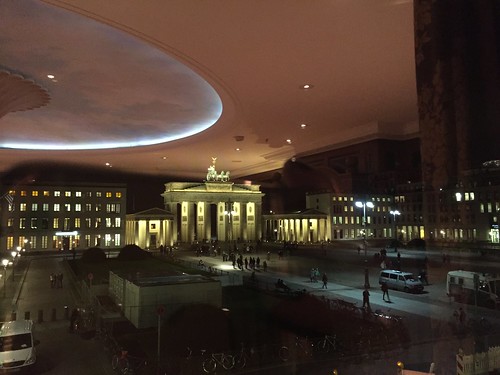This year’s Vancouver Marathon was not the best marathon I ever ran. A week before I could still hardly walk because of an injury, so I could not participate in the 10K Vancouver Sun Run. But I still decided to do the full 42.2 km marathon the weekend after that. The result was an even worse injury (but I finished, which is the only thing that counts), however, there was more.
I think our housekeeper washed my Vibram running shoes before the race, because while at the start I felt they were suddenly too small. During the race my big toe was very painful, but I continued anyway. I will spare you the details, but about 3 weeks later I lost my complete toenail because of this. I never realized how important even a toenail can be, I could not even swim for a few weeks because of that (too much pain).
But the strangest thing was that after the marathon my lower abdomen was hurting and it looked like I had suddenly grown a big tumor during the run. Kind of scary, so I went to see a doctor a few days later. He told me that it was a hernia, something that 10% of the people develop during their life, which was a bit of a relief. This marathon had been too much for my body it seems.
I did some research and managed to get an appointment with the best hernia doctor in Vancouver, Dr. Scudamore. He told me that it was an inguinal hernia. A surgery was not immediately necessary, but that not doing it could lead to potential complications such as strangulation (cutting off the blood supply to part of the body). Because the full recovery of such a surgery would be 6 weeks I decided to postpone the operation until after the summer (I wanted to go swimming and sailing in summer), and so last night I went in for my operation.
I have always been very healthy and never had an operation before. The only time I spent some time in a hospital was when Scott and Elaine were born in Shanghai. So I looked forward to it actually, I like to learn new things and this is the best way to observe how a surgery works.
While being tied to my bed in the operation room I asked the anesthesiologist a lot of questions and looked at all the monitors and other instruments surrounding me. I was put on an IV, which I had never experienced before. I was hungry and dehydrated (I had not eaten for 20 hours when I entered the hospital), but the IV makes you feel better soon. The view from the operation room was great, on the top floor of the building with windows all around and views over the city. Too bad I could not take a selfie!
Dr. Scudamore walked into the surgery room just before 7 pm (I already had a short chat with him 30 min before the operation in which I could ask him all kinds of questions) and informed the staff of the procedure. Then the anesthesiologist put a mask with 100% oxygen over my mouth and told me I would be asleep in 20-30 seconds. Breathing was kind of hard so I closed my eyes and took deep breaths. After 30 seconds I felt I was still not asleep and opened my eyes to tell the doctor that it did not seem to work. But I was surprised to see that I was suddenly in a different room and that the clock at the end of my bed showed it was an hour later! The surgery was over already and I had not noticed anything.
I felt fine and wanted to get up, but the post operation nurse told me to stay put. I was completely awake and asked her for something to read, but that was not possible. I had to lay down for at least another 45 minutes. That was very boring, because I felt great (thanks to the IV and all the medicine in my body) and I am not used to doing nothing for 45 minutes. There was a man in the bed next to me who had also had surgery and who seemed to be doing a lot worse. I could not see him because of curtains between the beds, but I understood that they had needed a lot more medicine to bring him to sleep and he was not in good shape when he had woken up right before me.
After a very boring 45 minutes in which I asked the nurse questions about the instruments, the surgery itself (the whole operation had lasted just 35 min), and post-operation procedures, and in which I was trying to come up with improvements for patients (why not put a simple muted TV screen above the bed to at least you can watch something without moving or hang some posters on the ceiling), I was finally allowed to get up. The nurse wanted to bring in a wheelchair but I said I wanted to try to walk myself. That went fairly well, but the nurse warned me that if I would fall she may not be able to catch me. After leaving the post-operation area I was told to go to the toilet (they don’t let you go until you prove you can do that!), which was kind of weird because the whole middle part of my body was completely numb.
Then another nurse came and put me in a wheelchair. I did not see the necessity for that but wanted to go home and just obeyed. She took me to Grace’ car and with some pain I managed to get in. I thought I would sleep most of the drive back home, but I was not tired and could even tell Grace how to drive (she prefers my directions over her navigation system).
At home I decided to walk around slowly instead of lie down because I felt fine. But all of a sudden my legs felt like jello and I fell backwards on the ground. I still don’t know what happened exactly, but it was a good lesson that I may feel okay but I was not yet okay just 2 hours after the surgery.
From then on I just sat down, had a lot of clear soup and then went to bed where I read some emails, wrote a couple of text messages and tried to read a book. By 11 pm I was supposed to take new painkillers, but I felt the pain was manageable so I did not take them yet.
The night was not easy because I could only lay in one position and woke up each time I moved. I was thinking about taking painkillers at 5 AM, but in the end decided to try to get through the night without them. The result was not much sleep, but I still felt quite rested. I also had a lot of time to think about the things I experienced in the hospital and what could be improved. Especially the information flow is quite limited, if you don’t ask you just don’t hear a lot of things. Also the waiting time at the hospital before the operation was unnecessary. Why let me arrive at 3:45 pm and not start the operation until 7 PM (I was told other operations took more time than planned)? Just give me a call in advance so I could have worked 2 hours longer. A simple app could have solved this. And maybe I am different from others, but I would have liked to see pictures or video of the operation, that would be a nice memory.
It’s now 9 AM, the kids are in school and I am sitting in the living room doing emails and WeChat messages. Pain is still manageable so I still haven’t touched my painkillers. I may do so later if I want to get some sleep, but if I can handle the pain without medicine I prefer that. Actually, the pain is a lot less than I thought. Several people told me it would hurt like crazy, but it’s actually not much worse than the pain during or after a full marathon. The main difference is that after a marathon you can lie down on your bed and feel much better, here the pain is very concentrated and doesn’t really stop.
Recovery will be quite slow, it will take about 3 weeks before I can do light activities again and it will take 6 weeks for a full recovery. Biggest problem is that I can’t drive for 2 weeks (time for self-driving cars!), but I believe I should be able to beat that time if I walk around a lot instead of hang on the couch. I am in pretty decent shape, so I assume that with healthy food and drinks my body should recover a lot more quickly than the average person would. We’ll see. At least it was an interesting experience that I actually enjoyed (I realize that might sound strange), I just wish there would be a bit less pain involved.


















